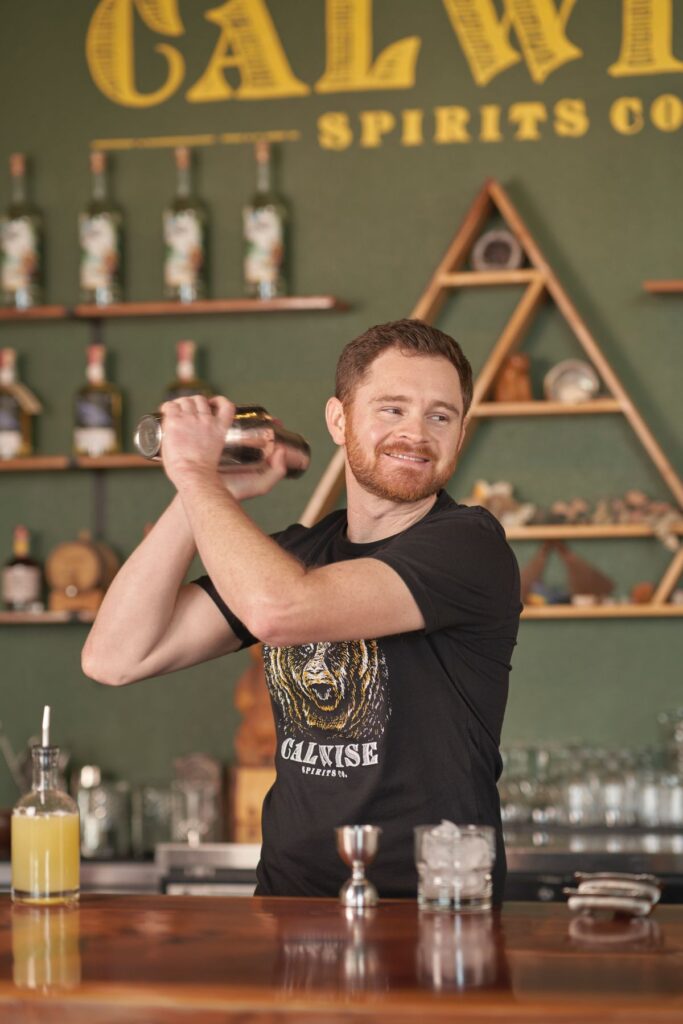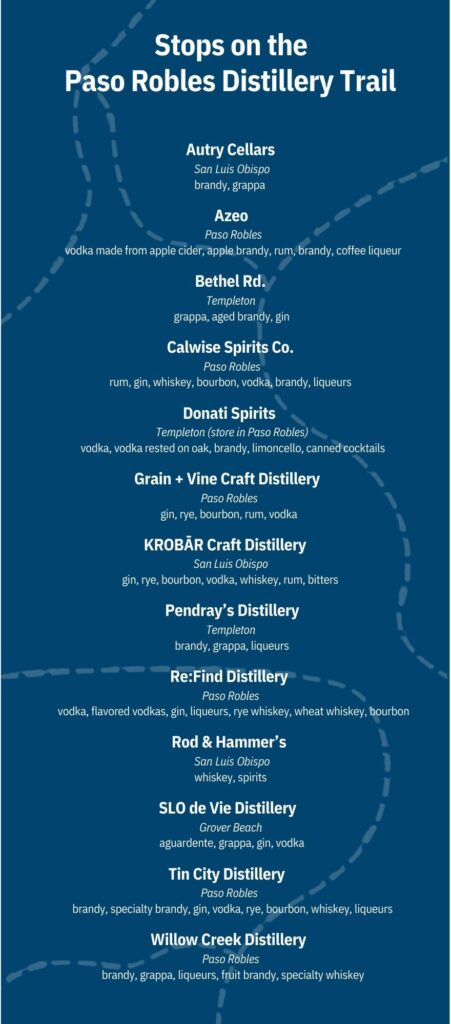
Paso Robles Distillery Trail Celebrates 10 Years and 13 Stops
This article shares the history of the Paso Robles Distillery Trail and how it’s developed over the years to support the growth of the county’s spirits industry. Writer Jonathana LaFerrara looks into the unique qualities and stories of the organization’s members.
By Jonathan LaFerrara
Photography by Hugo Martinez
It’s been over 10 years since winemaker Alex Villicana of Villicana Winery regrettably stared at prized grape juice that was going to go down the drain and wondered if there was a more sustainable process of making wine.
Many boutique wineries like his use the technique, saignée, or the bleeding off of liquid from a tank of juice for red wine to produce a better flavor concentration and color. This happens in the early stages of the winemaking process when the grapes are picked and crushed. A percentage of the pre-fermented juice is siphoned to increase the skin-to-juice ratio; red wines get color, concentration and tannin structure from the skins by reducing the amount of juice and increasing the amount of skin during fermentation.

“It is like putting a tea bag in a mug of water versus a gallon of water,” says Monica Villicana, who co-owns Re:Find Distillery and Villicana Winery with her husband Alex. “You will get more flavor and color concentration in the mug. [We wanted to] upcycle the sacrificed grape juice into top shelf spirits. That is a lot of fuel, water and manpower being reclaimed. This is how we branched [out] into the distilling business.” The residual juice that was going to go down the drain in the winemaking process is now recouped and distilled into spirits. Each year, Re:Find saves and repurposes the equivalent of a 70-acre vineyard’s worth of grape juice.
This is how one of the first distilleries in San Luis Obispo County came to be. Now there are close to 20 distilleries, 13 of which have banded together to form the Paso Robles Distillery Trail (PRDT), conceptualized in the summer of 2015 through discussions between Re:Find and four other local distilleries: Pendray’s, KROBĀR Craft, Bethel Rd. and Tin City.

“Our idea was to replicate their model. SLO Cal is such a special place in that like businesses actually see each other as collaborators versus competitors,” says Monica. “We capitalized on that spirit knowing that if we worked together, we would have a bigger marketing impact than if we operated individually. We are all under the philosophy of ‘the rising tide lifts all boats.’”
It’s a sentiment that Aaron Bergh, Distiller of Calwise Spirits Co., understands all too well. “The big spirits companies aren’t here to help us, so we have to help each other using our individual strengths,” he says. “If we work together, we can generate a lot more awareness about our growing industry. Craft spirits are the new frontier and we’re all trailblazers.”
Aaron himself comes from trailblazing distiller lineage. His great great grandfather started making moonshine whiskey during Prohibition to support his family, though he was ultimately caught by federal agents who destroyed his still with an axe. The top of that served as the inspiration for Aaron’s Axe Hole Whiskey, and still hangs in his distillery today
Aaron also serves as President of the PRDT’s Board of Directors. The organization, which turns 10 years old this year, is a member-run, member-funded 501(c)3 nonprofit. And thanks to Lynette Sonne, the organization’s first official Executive Director, the trail has leveled up.

The PRDT now is on par with distillery trails around the country, such as the world-renowned Kentucky Bourbon Trail, offering a road-trip style experience encompassing 46 bourbon distillers across Kentucky. One of the state’s most popular tourist attractions, it drew 2.5 million visitors from all 50 states and 25 countries in the last five years. Likewise, the much smaller but impressive Northwest Whiskey Trail stretches from British Columbia down through Washington and into Oregon, the first-ever international whiskey trail.
“Craft spirits are exploding in popularity,” Lynette shares. “So, I think we’ll see even more people working collectively. A lot of craft distillers in this area are also grape growers, and winemakers. They’re busy making and not necessarily taking the time to shine a light on what they’re doing.” That is where the PRDT comes in. Among other benefits, it ensures printed trail maps can be found in hotels and visitors centers throughout the county and at every distillery.
And though the trail has Paso Robles written all over it, the map includes distillers throughout San Luis Obispo County. In 2023 the membership voted to reconnect with its roots in Paso Robles and benefit from the destination draw of Paso Robles wine country. This encompassed a rebranding and name change from its previous “Distillers of SLO County.” Currently, the member furthest from Paso Robles is SLO de Vie Distillery in Grover Beach, a collaboration between owners Anatoly Rosinsky and Thomas da Rosa, originally from the Azores islands in Portugal and Russia, respectively. They started a craft distillery to continue the tradition of both their heritages.

“It’s interesting. You can go from Rod & Hammer’s, which is the trail’s biggest distiller and has wide distribution outside of our county, to SLO de Vie, which is the trail’s smallest distillery [based on production numbers]. It’s a boutique operation. The two companies have entirely different business models,” says Lynette. “That’s what’s fun with exploring through the trail. You can experience all different sizes and shapes. Everyone has their stories.”
The story of Max and Luke Udsen, who grew up as winery kids, stems from their father, Niels Udsen, who founded Castoro Cellars in 1983. After spending their lifetimes absorbing all his knowledge, together the brothers formed Bethel Rd. Distillery to concentrate on spirits. And though Aaron of Calwise Spirits Co. has distilling in his blood, his story really began in experimenting with distilling as a student at Cal Poly. He now makes both grape and grain-based spirits as an ode to the region.
There are a number of ways to hear these stories. One is through Distillery Trail Weekend, a three-day event in the summertime when each of the member distilleries showcases their craft spirits via distillery tours, mixology demonstrations and experiences with live music and food pairings. The next celebration is scheduled for August. Another way is with the Copper Card. This actual authentic copper, pocket-sized card offers holders exclusive membership with VIP experiences and trail benefits, like complimentary tastings at each of the distilleries, private tours and demos and access to club-only releases. Every time a Copper Card Club member visits a new distillery, their card gets hammer stamped.
“Raising the bar is our tagline,” says Lynette. “And raising that bar means making sure a good part of our mission is to educate. Educating on the abundance of spirits in our area and bringing more awareness for the area’s craft distillers — that’s the 40,000-foot view.”



